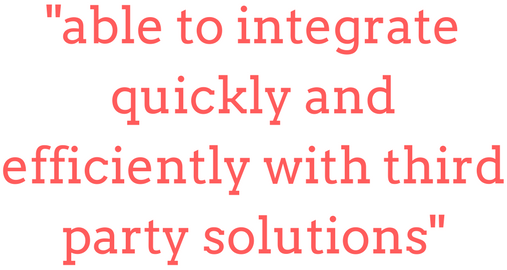
In The Frame – Prime Focus Technologies – How will Brexit change broadcaster’s business models?
Keen to follow up on our earlier blog post regarding Brexit and it’s implications for the broadcast industry we have sat down with the guys at Prime Focus Technologies to get a better understanding of how our clients are preparing for the potential changes in working practices for content owners and partners.
Ryan Leigh is Vice President EMEA at Prime Focus Technologies.
David Mortlock is Director of Business Development EMEA at Prime Focus Technologies
TP – How does PFT fit into the Prime Focus group?
Ryan: Prime Focus Technologies began as an incubated startup within the larger Prime Focus group; created in 2007 to service the media and entertainment space for TV.
The principle of our role within the business is to service the whole content supply chain from script to screen.
TP – How do you deliver this?
Ryan: Through our CLEAR Media ERP Suite
The key is using cloud-based infrastructure so we can free departments from geographical constraints and legacy technology.
CLEAR was initially conceived as a SAAS solution on the cloud, which was quite a radical approach at the time when compared with traditional on-premise systems.
Now with Brexit on the horizon, the liberation from one geographical location is quite an attractive way of managing your content as you can access and distribute your talent and resources outside of the UK and Europe. With our acquisition of DAX we can link the production chain with post and content management.

TP – What in your mind are the likely effects of Brexit within our industry? Both from a Technology and Staffing perspective.
Ryan: Longer term – it looks like changes in legislation with regards of accessing overseas resources, so those include technology, infrastructure and human resources.
Honestly, I think there are pros and cons to this situation.
Trying to access resources from Britain allows access to talent across the EU. In the future that talent would be limited in some way.
On the flip side, British talent would be promoted and there would be a change in how resourcing is handled for companies based in Britain. Large companies will still require specialist resource, to service their deliveries, their platforms and their channels, the issue is how they access that talent and whether it can be accessed locally and resourced locally by companies like Frame 25.
Cloud sourcing of that talent using technology like ours to work remotely with partners that are distributed throughout the EU, without the talent being physically in the UK. This could be a way of working around the restrictions that are likely to come in when it comes to free movement of people.
TP – What are the most pressing business challenges content owners are facing now? What are they looking at suppliers like PFT to provide them?
David: Flexibility and Agility. They want to add and deploy new services quickly. Not being anchored down with onsite infrastructure, and all the pre-existing legacy challenges that come with it, having to support it, having to then support the staff who support it.
Ryan: The general trend of the industry, is servicing multiple platforms. Moving away from traditional broadcast workflows and moving to different business models around online-only, VOD platforms like Netflix. This means that making large investments that are effectively capital expenditures on software that services their needs now is not something they can do, because the changes with new services are far more frequent now than they were before. It’s not as predictable as it was before, due to the changes in technology and demands on the content management platform.
Making a large investment on a fairly static on-premise infrastructure is not a wise decision. Having an Agile SAAS platform that develops among a large client base on a single platform is a more secure way of investing money into an operation.
TP – How are content owners dealing with this issue, are they building parts of the infrastructure in-house, outsourcing others or continuing with older technical infrastructure?
Ryan: It’s a real mix. Some large international broadcasters who have large in-house technical and IT departments and have invested tens of millions in their own systems. Over the previous decades they have been extremely successful in doing so, but keeping up with the trends in technology requires infinite investment that they just can’t continue to do.
I think there has been a general shift in attitude amongst those broadcasters to actually focus on what they need to do in order to survive. Do they focus on building IT systems or do they allow specialists to focus on that, and shift their attention to focusing on delivering high-quality content.
My personal view is content is always king, and that content is where companies live and die in the future. The key is focusing on what they are really good at which is delivering really good quality content and allowing IT companies to look after the technical backbone.
However on the flip side of that there are also companies that partway through that migration are not willing to write off investments, this is where CLEAR comes into its own. It offers flexibility to deploy parts of the system and then wrap around existing on-premise infrastructure in order to embellish it with new features that aren’t present in those legacy systems. There is no requirement to suddenly switch everything, it can be a gradual migration processes.
Clients like the option to build out functionality.
TP – How are PFT best placed to handle this transition?
Ryan: As a company we are flexible, and look to support customers with a solution rather than a product. That solution has to be tailored to our clients. In support of our software, we have a large services team that enable them the flexibility to move into the cloud for remote resources when they need them.
Our technology platform needs to be open and able to integrate quickly and efficiently with third-party solutions. While everyone will try to offer this ‘out of the box’, inevitably every project will involve some custom work.
TP – How much resource is behind these services?
Ryan: We have a large team of developers actively working on the CLEAR platform and an equivalent number in implementation, QA and Account Management with our clients.
We then have 12-1300 people working in services, QC, Editorial, Transformation, encoding, delivering to content platforms.
TP – Can you give us an example of where a client has used CLEAR and delivered significant savings.
Ryan: A good example would be promo automation.
This is a feature of the product that we showcased at NAB which allows clients to automate promo versioning workflow within a multi-channel operation.
Typically a client would have a piece of creative content – 30-sec promo with no graphics. Then they would reversion that for use over weeks and days in run-up to airing. They use branding templates to deliver these versions. What they are currently doing is using expensive editing resources and producers in order to reversion the promo.
With CLEAR we have features allowing a team to collaborate on delivery of the original creative material. We have added an automation piece with integration with Adobe Premiere Pro and the rest of the Adobe suite which allows us a template to inject each of those branded versions automatically into an Adobe Suite and have those rendered out without any human intervention.
We generate an automated list of versions that are required based on the schedule we then produce a delivery timeline with work orders. Giving a clear timeline of when processes need to be completed. A lot of the work is done out of hours when the editors machine is not being used, so effectively reducing the manpower of reversioning by half.
Allowing a better use of the creative staff, enabling them to cut creative promos rather than spending more time reversioning.
David: – It’s classic situation – operations leaders are always being asked to be more cost-effective and need to address how to make a facility work more efficiently, if machines can work overnight for you, then schedule the work for then and maximize your investment in technology

TP – CLEAR has some key technology partners can you tell us about those?
Ryan: CLEAR provides the glue and workflow orchestration between a variety of cloud and on-premise systems. It’s important to note that we are not, for example, going to try and reinvent transcoders, there are very capable transcode companies out there whom we partner with. We leverage the best of breed technologies.
David: For example, our AWS Optimizer.
Ryan – So we have a list of vendors who provide auto QC, what a broadcaster needs is a holistic view of what is going on across the operation.
As part of our Amazon integration, we have a number of optimization workflows.
David: We have an exclusively licensed algorithm with a third party that allows us to interact with AWS and find the best most efficient way of processing content. So we set the threshold of spend and time you want to commit to the job being completed and we can then go and bid for those resources on Amazon cloud automatically. So we can make sure your content is processed in the most efficient way, within limits you set. This is something that is exclusive to our product set.
Ryan: So we can secure the resource and use our workflow orchestration tool to spin up an instance of the relevant service to complete the task at the most cost-effective time for non-urgent requirements.
If our client uses or plans to use AWS we can offer them the use of this algorithm.
David: As confidence moves to the cloud, with broadcasters allowing their content into a virtualized infrastructure. We expect the uptake of this feature to be significant as the value prospect is massive.
We have seen 80% savings during testing in transcoding workflows, purely by leveraging resources more effectively.
Ryan: We are using these tools to try and relieve pressure on certain points of the chain so you can build a more predictable factory approach to handling your content.
TP – There are a number of companies building similar products to CLEAR – who do you see as your main competition?
Ryan: We operate in a number of different spaces.
We are a services company, and there are large services companies out there who offer things like specialist language and localization, Vod, QC, Compliance services that do very well in Europe who we compete with.
On the technology side, the core of our system is similar to a MAM solution. However, we don’t like to label CLEAR as a ‘MAM’ system due to the layers of functionality it provides.
There are newer players who are providing something similar to CLEAR but they might not have the breadth or depth of features that CLEAR has. They are likely to offer some of the same flexibility but they might not have the same level of resources and won’t be providing a true end to end solution.
David: Also allowing them to still utilize their investment in existing kit. Unless you are green-field, you are always going to have legacy equipment.
TP – What do you see the landscape looking like for content owners and technology partners in the next decade?
Ryan: I see one trend as the leveraging of remote resources, and leveraging those resources through cloud infrastructure.
We work as a technology partner – using our resources and also working with others.
Its that kind of approach where a technology company becomes an enabling partner that gives the client access to a wider pool of talent.
David: Traditional tools mean staff have to be onsite, using and attending the edit session, in an edit suite. The way people work is changing. This can now be performed remotely.
TP – We certainly see a lot of clients moving to a contractor staffing model for similar reasons. Which types of roles in the broadcast technology sector do you see changing and being affected by the move to cloud technology within the broadcast chain?
David: For example, we can be making some compliance decisions in the early stages of media being created. Closing up black holes, you don’t need an editor to sit there and do that job.
Ryan: It liberates skilled workers from spending time completing manual repetitive tasks like reversioning and allows them to focus on the creative editing function of their role.
David: It’s the battleground of quality. As soon as you have a product of poor quality people move away from it quite quickly. So free up talent to focus on quality. As everyone starts to be able to distribute content more efficiently quality will become ever more important.
Ryan: There will be drastic improvements in the quality of content. I think there will be opportunities for the creative talent to effectively move to a more freelance model. With creative editing jobs able to be done remotely. I would expect a smaller in-house team of talent with a larger reliance on the broader availability of remote talent.
More and more industries are relying on a remote workforce, increasing quality of content and using time more efficiently.
TP – We are seeing that the contractor marketplace in certain areas frequently provides a higher level of experience and skills compared to staff candidates.
Ryan: We see that with BA, PM and in London more DevOp roles – purely being contract due to being project related. Projects won’t last forever so why have a large staff team.
TP – In order for Broadcasters to move to a more OPEX focused model from a technology standpoint, they need to be asking themselves ‘ what are we? a technology company or a content company?’.
David: The ability to deploy quickly will be sink and swim in our business. I have worked with vendors who have so much red tape so that making small changes takes so long.
CLEAR is a pay as you go Opex model. You don’t need to put a huge build into your operation, onboarding a new OTT/VOD platform, support it and then make changes to it whenever a spec is revised or a new platform comes in. Why do that? Why not give that challenge to someone else and make sure your SLA is tight. Take the pain out of the delivery and put more effort into upstream functions which will improve discovery, quality and the ability to be able to deploy quickly, such as S&P tagging and content cataloguing.
TP – Can you tell us about a recent deployment of the CLEAR platform?
Ryan: So we have just rolled out our largest deployment in Europe; a greenfield 4K Ultra High Def original content broadcaster.
We have connected all their production partners who are scattered across Europe onto CLEAR. They are all connected for delivery of rough and fine cuts and full-res TX masters through CLEAR. We use an Aspera backbone to deliver those to run auto and manual QC in-house.
Also applying a B2B portal through CLEAR, so they can monetize their 4K original content.
It’s been a big challenge, bringing in all the information associated with the content, not just the technical side. Managing the contracts for the talent, insurance policies etc. So we have something like 36 deliverables for every single asset – all managed through CLEAR.
David: Visibility of workflow and status of workflow is crucial. If you can give the relevant parties a centralized hub where all relevant information is stored and displayed, you will inherently increase efficiencies.
Situation I have experienced begin with a call requesting an update on the status of delivery of materials for TX from the Scheduling department, this is referred to the Compliance team, who then contact Editing, who then get in touch with Operations, who then call the playout provider ( if not doing their own TX ) to find out whether material have been received and are ready for air … why do that when a single interface can offer the same information, instantly, saving a lot of time and effort?
All delivered in an Agile methodology.

Summary
The need for capex-heavy investment from broadcasters and content owners is a topic of much discussion as hardware-based broadcast technology moves into software and virtualized cloud environments.
Businesses are now looking to adopt a more opex-focussed model as more of the technology chain is outsourced to specialist partners.
The contractor staffing model to support this gradual shift has grown considerably over the last decade and continues to grow in order to provide key flexibility and agility to businesses who need to scale quickly.
At Frame 25 we have invested in a number of cloud-based tools to make accessing talent easier and consistent. Our clients need to be able to scale their workforce as and when needed. Access to talent won’t always be local and Brexit is likely to emphasise this. A focus of our business will remain upon using technology to access talent outside of the immediate area of availability.
We shall be at IBC on Friday 9th and Saturday 10th next month, meeting clients and contractors. Get in touch if you want to discuss your next project with us.
Prime Focus shall be exhibiting in Hall 7 stand B12.
Further Reading
http://www.primefocustechnologies.com/
http://www.primefocustechnologies.com/sites/all/downloads/pdfs/Sales_Factsheet_Web.pdf

Umbrella Company Reforms - An Overview

Product + audience + platform: why the Premier League is going its own way
